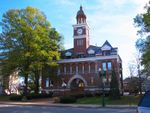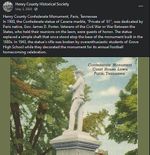Paris, Tennessee
Authors [about]:
join in to develop this article! |
Paris, Tennessee (USA) is a small town of about 10,000 people in West Tennessee. It was founded and incorporated in 1823. Paris is in the geographic center of Henry County (which has 32,363 residents in 2021, including Paris[1]). The county and town are struggling economically; as of 2021, the poverty rate of around 20% is more than twice the national average[2].
In August of 2020, the Lee Academy for the Arts (402 Lee St.) was renamed as Paris Academy for the Arts, and its board of directors (formerly called the Robert E. Lee School Association) renamed itself as the Paris Academy Association. The site and building had born the name of confederate general Robert E. Lee for well more than a century.[3]
The county is in the upper right corner of West Tennessee bordered by Kentucky (north) and the Tennessee River (east), and Paris, being in the center, is the county's legal and administrative seat. The heart of the town and county is a "court square", a city block on which stands an imposing court house which dates from 1897[4]. On the courthouse lawn stands a statue of an anonymous confederate soldier[5], one of many monuments around the U.S. earmarked by the InvisibleHate.org website in 2020 as appropriate for removal (possibly to a less prominent location such as a private cemetery containing the remains of confederate soldiers).
This is a placeholder reference[6]
The indigenous people before European settlers
How the early European settlers obtained deeds to the land
The pre-civil-war schools
The pre-civil-war economy
Slavery around the time of the civil war
In the decade leading up to the civil war, most of the economy of Henry County came from moderate-sized farms between 20 and 500 acres; their owners and families were the main demographic of the county at that time.[7]. Three other groups existed in small pockets only: large plantation owners, poor whites, and free negroes. Per the county census figures, a third of all heads of these farm families owned slaves in 1850. Tobacco and cotton were important crops, and the labor for those crops was done almost exclusively by slaves, who constituted a quarter of the overall population, but lived on only a third of the farms[8]. The county's slaveholders had great influence with politics of the day. Two-thirds of Henry County voters elected to secede from the union, and any Union sentiment in the remaining third of the population was brutally suppressed[9], not only in Henry County but in most of West and Middle Tennessee. During this period, Isham G. Harris and John D. C. Atkins, both strongly pro-southern in sentiment, were very popular and acted as the main political voices in Henry County[10].
Cost of slaves in 1839
The following rates were paid for slaves in Henry County during a sale in February 1839:[11]:
- man: $900 to $1000
- woman: $700 to $900
- child: $600 to $800
In terms of 2021 monetary worth, the cost per slave would be:[12]
- man: $25,209 to $28,010
- woman: $19,607 to $25,209
- child: $16,806 to $22,408
It is important to realize that slave-owners had invested substantial funds in their source of labor and believed that abolition of slavery would ruin the economy and way of life. Their participation in the civil war for the South was in every way an attempt to protect against having their right to own slaves infringed. The struggles for and against slavery throughout the thirty years leading up to the civil war were apparent in almost all parts of the Southern states, as well as the newly added territories, where the questions were twofold: Would slavery be allowed in this new territory, and would the new territories have to return escaped Southern slaves to their masters?
Image gallery
These will be placed later
References
- ↑ Henry County, Tennessee Population 2021 on World Population Review, last access 1/27/2021
- ↑ Henry Co., TN, Population Data Profile, last access 2/15/2021
- ↑ The PI (Paris Post-Intelligencer) Aug 28, 2020 article PARIS, TN: Former Lee school building gets name change, last access 2/15/2021
- ↑ Per the National Geographic Tennessee River Valley website (last access on 11/30/2020), the 1897 Richardsonian Romanesque courthouse in Paris is the oldest working judicial building in West Tennessee.
- ↑ Waymarking: Henry Co. Confederate Monument, Paris, TN, last access 1/17/2021
- ↑ Antebellum Henry County by Roger Raymond Van Dyke, West Tennessee Historical Society, Papers 1947-2015, Vol 33, 49pp; see page (tbd)
- ↑ WTHS, Van Dyke p 72
- ↑ WTHS, Van Dyke pp69-71
- ↑ WTHS Van Dyke, p 73 and p 78
- ↑ WTHS Van Dyke, p 74
- ↑ WTHS Van Dyke p73
- ↑ https://www.officialdata.org/us/inflation/1839?amount=1

